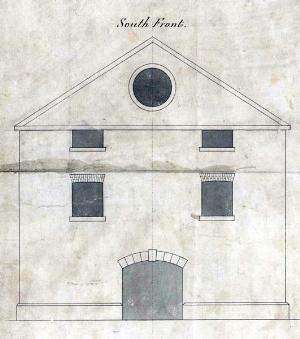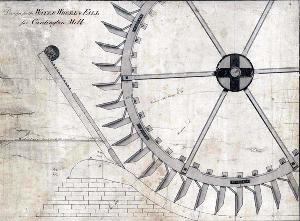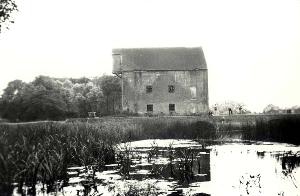Cardington Mills

Elevation of Cardington Mill in 1779 [W1272]
The site of Cardington Mill lies in Priory Country Park. This means that, despite its name, the site now, since boundary changes, lies in the south-east part of the Borough of Bedford rather than within the parish of Cardington.
A mill was recorded as belonging to Cardington Manor in 1086. It was recorded as being worth £2 and 100 eels. It seems reasonable to assume that this 11th century mill was either at or near the site of the later mill on the Great Ouse at the modern Priory Business Park.
A mill was recorded as belonging to Cardington Manor in 1086. It was recorded as being worth £2 and 100 eels! It seems reasonable to assume that this 11th century mill was either at or near the site of the later mill on the Great Ouse at the modern Priory Business Park.
The ownership of the mill followed the same course, naturally, as the ownership of the Manor of Cardington [q.v.]. After Domesday Book the next mention of the mill comes in an unusual survival, a lease in English from the year 1470 [W44]. The lease was for 40 years and was from the Lord of the Manor, George Gascoigne to Thomas Wytston of "his mylles in…Cardyngton…with waters fro a place called called the washyngstole of the priory of Newenham unto the werkes of Castell Mylles, with all order waters and holmes, osyzer beddes…rede beddes with the molber of fre men and bondmen". The lease stipulated that a new mill house was to be built after Christmas that year and was to measure sixty feet by sixteen and was to stand beside the mills and a floodgate made with stone above the west end of the mills. The landlord was to make the mills before Christmas "able and sufficient to grynd all maner of greynes" but if only one mill was ready the rent was to be reduced accordingly. The landlord was also to "fynde all maner of stuffe and costs of werknenshypp, that is to say, of and for water whelys, water yates, mills stones, cogge wheles, trendels, cogges, rowngges, reynndes, spyndeles, hoppes, stone, grete tymber and small splentes, wyndyng roddes, strawe and all maner of carynge to the reparacion of the said milles and howses" and within four years was to "ordeyne Mills stones called frenshstones to on of the seyd milles" whilst the tenant would "ordeyne Mills stones called Peckstones to the oder": All this indicates either that the mill was in quite a run down condition by 1470 or, perhaps, had become disused altogether.
Some other leases from the next two centuries survive including a lease of 1577 for 21 years [W318] from Thomas Colby of Hampshire, esquire to John Wolriche of Cotton End, gentleman, of two water mills called Cardington Mills with land and other buildings. In his will of 1580 [ABP/R19 folio 150] William Cannon devises his malt mill and mill house in Cardington. It is unclear whether this is Cardington Mill or another mill in the parish (perhaps the windmill at Harrowden), but it is possible he was an undertenant of Wolriche.

Cardington mill wheel in 1779 [W1272]
A witness deposition of about 1663 by Robert Mascall survives [HA272] in a case clearly about maintenance of the dam and in it he said that 60 years before [i.e. c.1603] his uncle James Henley had rented Cardington Mills and did not repair the dams beyond the ground he was renting from the Lord of the Manor nor did a man called Fisher who married his uncle's widow and succeeded him. He went on to say that About 55 years before [i.e. c.1608] the Marquess of Northampton who owned Newnham Priory and the Manor of Cardington were in dispute about the amount of water the Cardington miller kept in his dam and a jury had held that if there was a breach in the dam the owner of the adjoining meadow should repair it:
A lease for 21 years of 1628 [W319] from Sir Arthur Savage of Cardington to Joseph Stevens of Mogerhanger, miller survives in which the number of mills has risen to three water mills under one roof (one wheat and two rye) as well as a fulling mill. A schedule of implements is included as follows:
- 3 good millstones;
- 1 old bedstone and 2 good ones;
- 4 good mill brasses and stepp brasses;
- 3 new spindles and 3 mill ryndes;
- 3 hoppers;
- 3 good new troughs;
-2 good cables and 1 roape and 1 beetle or greate hammer of iron".
In 1671 a suit for damages [W320] was brought against three local men, Robert Fisher, late of Cardington, labourer, Mathew Ashwell, late of Fenlake, labourer and Edward Gascoyne late of Fenlake, labourer by William Bedell, gentleman accusing them of coming armed at a place called Louch in Fenlake and digging up and taking away earth from two acres belonging to Bedell. Their defence, which was accepted by the jury, was that the Lord of Cardington Manor, Sir William Palmer, had held mills on the Ouse "time out of mind" and had the right to dig earth at that spot and that they were simply carrying out his bidding. A few years later, in 1689, Thomas Palmer of Warden Street conveyed a of a piece of meadow called Millersholme on the north-west side of Cardington Mills with full power and liberty to make and maintain a sluice for passage of boats and lighters [W321].
In 1693, Charles Palmer of York took out a mortgage with Dame Mary Thompson of York secured on three water corn mills with house, barn, stables, outhouses and three acres of pasture in occupation of Cooper as well as other land in Cardington [W322]: the mortgage was repaid in 1712. Samuel Whitbread became owner of the mill, and of Cardington Manor, in 1779 and set about rebuilding the mill (it was to rebuilt at least twice more, following fires, in 1823 and 1840 by William Henry Whitbread). Plans of the mill of 1779 survive by John Smeaton (1724-1792) who had been awarded gold medal in 1759 for an experimental enquiry concerning wind and water to turn mills [W1291-1293] and in 1784 he was making experiments to test mill owing to miller's complaints [W1/1300]. He found that: "By the last Experiment, the mill ground 13 bushel/hour [of wheat]. call this 12, and allowing one sixth to be deducted for the purpose of Boltin and Regrinding, it will then be 10 bushel per hour and even if one was to allow for incidents, repairs &c it cannot be rated at less than 8 bushel/hour the year through". Smeaton also built Cardington Bridge.
Correspondence of 1812 [W1/1390-1391] notes a man called Thorogood having been tenant and having paid up rent arrears, some of which being returned as compensation for buildings. He was succeeded in that year by a man named Thomas White, who agreed to expend £50 on repairs, he also wished to rebuild mill house, the old one being in bad repair. Further information, provided by Glyn White, is that Thomas White lived from 1775 to 1852, he ws the son of the Cardington churchwarden. Details of construction of the new house survive [W1/1392] but not, sadly, the plans mentioned in the correspondence as enclosed. The mill wheel clearly needed repairing by 1829 as correspondence in that year [Z477/31] notes that an assistant of Francis Giles was to visit and measure mill wheel so that Giles could then advise how to repair it, he also promised to comment on a proposal to change the mill from a common undershot to a ground shot.

Cardington Mill in 1929 [Z50/24/1]
Nineteenth century directories refer to Cardington Mill and note that in 1876 it was leased by the Ransome family, who also operated Kempston Mill. the 1894 directory notes that the mill was steam driven. As far as can be seen the final improvements made at the mill came in the early 1890s when the steam gear was introduced [W4040 p.82]. Certainly, by 1919 the mill was recorded as not working [WW1/AC/DR1]. In 1927 a survey as part of the 1925 Rating Valuation Act, was carried out and the valuer found it to be "practically disused", he "called there but did not see [J.J.] Payne [the miller] last year did a little grinding, almost derelict". It was purchased by Bedford Corporation around that time and was demolished in 1936, a sad end to a venerable tradition. The mill once stood just north-east of the public car park at Priory Business Park which gives access to Priory Country Park.

The site of Cardington Mills in March 2007